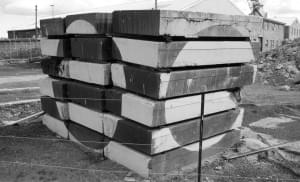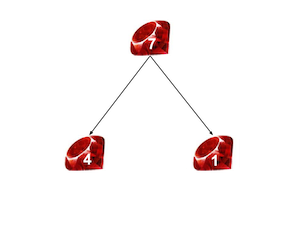
The study of data structures and algorithms does not have a huge following in the Ruby community because we often ask “what’s the point?” In practice, we rarely have to implement classical structures such as stacks and queues. But, by learning about them, we can improve our ability to reason about code. More importantly, data structures are very interesting to study!
In this article, we’ll cover the “heap” data structure along with some of the associated algorithms. I’ll assume that you have a basic handle on asymptotic notation and Ruby.
Motivation
We all have waaay too many emails. In an example where we’ve managed to assign every email in our inbox a priority or a key value (i.e. a number), we want to be able to do the following things:
- Get the email with the largest key
- Remove and get the email with the largest key
This will have to deal with a lot of emails, so we want these operations to be pretty fast, asymptotically speaking. What data structure should we use to achieve these goals? Turns out that by using a heap, we do Operation #1 in \(O(1)\) time and Operation #2 in \(O(\log_2{n})\).
The Concepts
More specifically, we’ll be dealing with a “max heap”. From here on out, we’ll use the terms “max heap” and “heap” interchangeably. A max heap can be visualized as a partially complete binary like this:
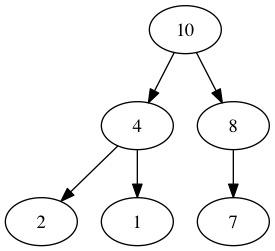
The thing that makes it special is that, for any node, the children of that node have keys smaller than or equal to that of the node. Note that in the figure above, the keys for each node are written within the node. Generally, heaps are actually stored as arrays. So our example above would look this:
[10, 4, 8, 2, 1, 7]We create the array by going top to bottom and left to right through the binary tree representation and appending the node keys to an array. It is important to know that not all arrays are heaps. For example, take:
[2, 1, 7]We can visualize that as:
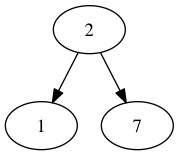
which is not a heap since \(7 > 2\). Basically, a heap is an array with the special condition that, when visualized as a tree, the max heap property holds. In other words, the children of each node have key values smaller than that of the node itself.
Constructing a Heap
The first problem that we have is our list of emails could have an arbitrarily ordered array of priorities that might not form a heap. How do we take this array and order it so that it forms a heap?
Well, that seems like a pretty complicated problem to tackle all at once, so let’s deal with a smaller version of it first. Let’s say we were given an array that was just one “swap” away from becoming a heap. So, we have some node v so that both its left and right subtrees are heaps but the subtree rooted at v is not a heap:
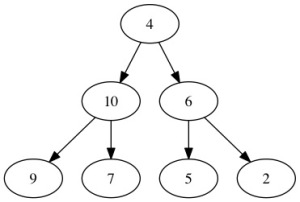
We can resolve this issue recursively. First, switch the 4 and the 10. Then, we have nearly the same problem once again, just in a different place in the tree since \(9 > 4\) and \(7 > 4\), so we can solve it using the same method. We keep doing that until \(4\) “sinks” to the bottom of the tree and becomes a leaf. Here’s how our approach will work:
fix_one_error(array, index):
1. If array[index] is a leaf node or is greater than both its children, return.
2. larger_index = the index of the larger child of the node at array[index]
3. Swap array[i] and array[larger_index]
4. fix_one_error(array, larger_index)Alright, let’s implement the ideas in Ruby. First of all, we need a couple of methods to give us the indices of the children of a given node in the array representation:
class Heap
attr_accessor :heap_size, :array_rep
def left_child(index)
2*index + 1
end
def right_child(index)
2*index + 2
end
def left_child_key(index)
@array_rep[left_child(index)]
end
def right_child_key(index)
@array_rep[right_child(index)]
end
endSecond, we need some way to see if a given element is a leaf node or not:
class Heap
...
def leaf_node?(index)
return index >= @heap_size/2
end
...
endFinally, we need to be able to tell if a node already satisfies the max heap property (in which case, we don’t need to keep fixing errors):
class Heap
...
def satisfied?(index)
@array_rep[index] >= left_child_key(index) and
@array_rep[index] >= right_child_key(index)
end
...
endThe details of how these four methods work aren’t incredibly important, but drawing out a few heaps with the array indices marked can make their inner mechanics pretty clear. Now, we can write out our algorithm in its full glory:
class Heap
...
def fix_one_error(index)
return if leaf_node?(index) || satisfied?(index)
left_child_key = @array_rep[left_child(index)]
right_child_key = @array_rep[right_child(index)]
larger_child = if left_child_key > right_child_key then left_child(index)
else right_child(index) end
@array_rep[index], @array_rep[larger_child] = @array_rep[larger_child],
@array_rep[index]
fix_one_error(larger_child)
end
...
endNotice that we’ve followed the pseudocode/description very closely. Repeatedly swap until either the node satisfies the max heap property or it has floated down the tree to become a leaf node.
Complexity of “Fix One Error”
At first glance, we might think that our fix_one_error algorithm is \(O(n)\), but upon actually solving the recurrence we find that it is \(O(\log_2{n})\). The intuitive reasoning is pretty clear: Each swap resulting from a call of fix_one_error takes \(O(1)\) time and when we have \(n\) elements, our tree has \(\log_2{n}\) levels in it so we end up with \(O(\log_2{n})\) as our time complexity.
Finishing Up the Construction
But, we haven’t solved the whole problem of converting an arbitrary array into a max heap quite yet. So far, we’ve only solved the case where there is only one error. As it happens, we can repeatedly use the “one error case” to solve the whole problem!
First of all, notice that leaf nodes, by themselves, automatically satisfy the max heap property since they do not have any children. Now, consider the nodes that are one level above leaves, i.e. only have leaf nodes as children. These nodes can only be, at most, one swap away from satisfying the max heap property. This means we can use our fix_one_error function in order to make sure that all nodes that are one level above the leaves form heaps (or, satisfy the max heap property). Now, when we move up another level, we know that everything below satisfies the property, so we can use fix_one_error yet again! Essentially, starting from just above the leaf nodes, we can repeatedly apply fix_one_error in order to convert any array into a heap.
Complexity of Heap Construction
We can answer pretty easily when asked for the time complexity of constructing a heap. With \(n\) nodes, run fix_one_error on every node and the complexity for each is \(O(log_2{n})\). Therefore, our heap construction algorithm should be \(O(n\log_2{n})\), right?
While this is correct, it turns out that we can do better (i.e. find a tighter bound)! Our complexity for fix_one_error is related to what level in the whole tree it starts out: the higher it is, the more time it will take. In fact, this relationship is linear. In other words, fix_one_error can be characterized as \(O(h)\) where \(h\) is the height from the leaf nodes at which fix_one_error is called. But, as we move higher in the tree, there are fewer and fewer nodes. If you take the time to sum up the series that results when analyzing the complexity, you can show that our algorithm can run in \(O(n)\) time.
Implementation
Enough talk, let’s see the full implementation to create a heap:
class Heap
...
def create_max_heap
(0..@heap_size/2-1).to_a.reverse.each do |index|
fix_one_error(index)
end
end
...
endWhoa, that’s pretty succinct! Basically, we are starting with the leaf nodes and then gradually moving up the tree, fixing errors as we go along.
Operations on a Heap
Let’s wind all the way back to our problem with the emails. Say we have the heap constructed and want to get the maximum priority element out of it. Simple! Just return the first element:
class Heap
...
def get_max
array_rep[0]
end
...
endThe procedure of extracting and returning this element is a bit more complicated, but really shows where heaps shine. We take the last element of the heap and switch it with the first (i.e. the maximum element). So, everything aside from the new first element still satisfies the max heap property. Now, use fix_one_error on the root node to make the array a heap again! But, before doing that, decrement the size of the heap to get rid of the last element (which used to be maximum element of the heap) once and for all. Let’s see it in Ruby:
class Heap
...
def get_and_remove_max
array_rep[@heap_size-1], array_rep[0] = array_rep[0], array_rep[@heap_size-1]
@heap_size -= 1
fix_one_error(0)
end
...
endWrapping It Up
I hope you’ve enjoyed this tour of the heap (and, implicitly, the priority queue) with implementations in Ruby. Drop any questions in the comments below!
Frequently Asked Questions (FAQs) about Heap Data Structure in Ruby
What is a heap data structure in Ruby?
A heap data structure in Ruby is a specialized tree-based data structure that satisfies the heap property. This property specifies that if P is a parent node of C, then the key of P is either greater than or equal to (in a max heap) or less than or equal to (in a min heap) the key of C. The node at the “top” of the heap (with no parents) is called the root node. The heap data structure is particularly useful when implementing priority queues where the queue item with higher weight is given more priority.
How is a heap data structure implemented in Ruby?
In Ruby, a heap data structure can be implemented using an array. The array is visualized as a nearly complete binary tree. The parent nodes and child nodes are related by their indices in the array. For any given node at index i, its left child is at index 2i + 1 and its right child is at index 2i + 2. The parent node for any given node at index i is given by the formula (i – 1) / 2.
What are the main operations of a heap data structure in Ruby?
The main operations of a heap data structure in Ruby include heapify, insert, extract, and delete. Heapify is a method to convert a binary tree into a heap. Insert operation is used to add a new key to the heap. Extract operation is used to remove and return the root from the heap. Delete operation is used to remove a key from the heap.
How does the heapify operation work in Ruby?
The heapify operation in Ruby works by maintaining the heap property. If the heap property is violated, then the node is swapped with one of its child nodes. This process is repeated until the heap property is no longer violated.
How does the insert operation work in Ruby?
The insert operation in Ruby works by adding a new key at the end of the heap. If the heap property is violated, then the key is moved up until the heap property is no longer violated.
How does the extract operation work in Ruby?
The extract operation in Ruby works by removing and returning the root from the heap. The last key of the heap replaces the root and the heap property is maintained by moving the key down until it is no longer violated.
How does the delete operation work in Ruby?
The delete operation in Ruby works by replacing the key to be deleted with the last key in the heap and then reducing the size of the heap by one. The heap property is maintained by moving the replaced key up or down until it is no longer violated.
What is the time complexity of heap operations in Ruby?
The time complexity of heap operations in Ruby is O(log n) for insert, extract, and delete operations. The heapify operation has a time complexity of O(n).
What are the applications of heap data structure in Ruby?
The heap data structure in Ruby is used in various applications such as implementing priority queues, supporting heap sort, finding the kth largest or smallest element in an array, and in graph algorithms like Dijkstra’s algorithm.
What are the advantages and disadvantages of using a heap data structure in Ruby?
The advantages of using a heap data structure in Ruby include efficient implementation of priority queues and sorting algorithms. The disadvantages include the complexity of implementation and the need to maintain the heap property.
 Dhaivat Pandya
Dhaivat PandyaI'm a developer, math enthusiast and student.

